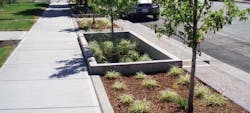Status Update
As more is learned about storm water runoff and how different climates should handle and treat it, state regulatory agencies across the country are starting to accept that there is no one-size-fits-all municipal storm water permit. What is good for one area of the country may not be good for another, and so, while the federal standards should continue to serve as a base guideline, some states are modifying the federal permitting requirements to better suit the hydrological conditions of their areas.
One of those states is Washington, which has a Phase I permit for large municipal separate storm sewer systems (MS4s) as well as two different Phase II municipal storm water permits for all regulated small MS4s: one for Eastern Washington and one for Western Washington. The new permit for Western Washington went into effect in August 2013; the new permit for Eastern Washington will go into effect in August 2014.
West Versus East
The Western Washington storm water permit now requires the most populated areas of the region to use low impact development (LID) practices and to begin monitoring water quality. The Phase I permit covers the cities of Seattle and Tacoma, as well as King, Snohomish, Pierce and Clark counties. The Phase II permit covers 80 medium and small cities, and the urban portions of four counties. Deadlines for the various areas to begin using LID are staggered from June 2015 to 2018 in order of most populated regions.
When it goes into effect, the Eastern Washington storm water permit also will require the use of LID, giving local governments until the end of 2017 to implement LID and allowing flexibility to tailor the practices to local conditions. The Phase II permit covers 18 cities and portions of six counties and also will require communities to monitor how effective their programs are.
Monitoring Program
The need for a regional monitoring requirement in both permits was realized after local governments, nongovernmental organizations, the Washington Department of Ecology and other state agencies determined that the best way to monitor water quality and effectiveness of practices was to work together.
“We agreed that the best way to handle monitoring was to pool resources and answer [questions of effectiveness] collectively, instead of each jurisdiction doing its own studies,” said Bill Moore, P.E., manager of program development services, Water Quality Program for the Washington Department of Ecology.
Measuring effectiveness will help answer questions such as whether more frequent street cleaning or an additional construction inspection will reduce the amount of sediment that accumulates in catch basins.
Changes & Challenges
One change that is reflected only in the Western Washington permit was nixing the federal 1-acre regulatory threshold.
The first filter for this threshold, according to Moore, is to ask whether more than 1 acre of land is being disturbed during development. If the answer to that is yes, then the next question is whether more than 10,000 sq ft of impervious surface are being added. If the answer to that is yes, then developers must apply some flow control practices during construction. The next question to ask is whether more than 5,000 sq ft of pollution-generating impervious surface are being added during development; if that question is answered in the affirmative, then developers must provide storm water treatment at the site.
There was a problem with using this threshold in Western Washington, however, according to Moore.
“Under the 2007 permits, it’s conceivable that you are developing
0.999 acres, which would not trigger the requirement to put in flow control or treatment at that site,” he said. “We realized that doesn’t make a lot of sense in Western Washington from an environmental standpoint, because the information we have says that most sites being developed in Phase II jurisdictions are less than 1 acre, so most of the development there was going in without storm water controls.”
The Department of Ecology determined that it made more sense to apply technical thresholds to assess whether a developer needed to apply storm water controls, regardless of the 1-acre disturbance threshold.
“We found that when you disturb roughly 4% to 5% of impervious surface within a watershed, you start to see adverse impacts,” Moore said. “That’s why we revisited the Western Washington permit.”
The decision was made to keep the 1-acre threshold in the Eastern Washington permit, in part because the climate is drier and more of the storm water is kept on site than in the west. Eastern Washington’s soils are not as tight, meaning storm water more easily infiltrates back into the ground.
“It’s a different world when you’re dealing with 50 in. of rain in Western Washington versus 20 in. of rain in the east,” Moore said.
He added that it has been a challenge to figure out how to manage storm water in a post-development situation to ensure it does not enter streams any faster than it would in a pre-developed forest condition.
“That’s something that we’ve been struggling with in this region—hence the move to LID techniques, which rely upon distributed storm water practices to get the water infiltrated into the ground,” Moore said. “We’re transitioning from a practice of moving water off site as quickly as possible to keeping it on site and putting it in the ground in a responsible way—and that’s been a challenging transition.”
Download: Here


